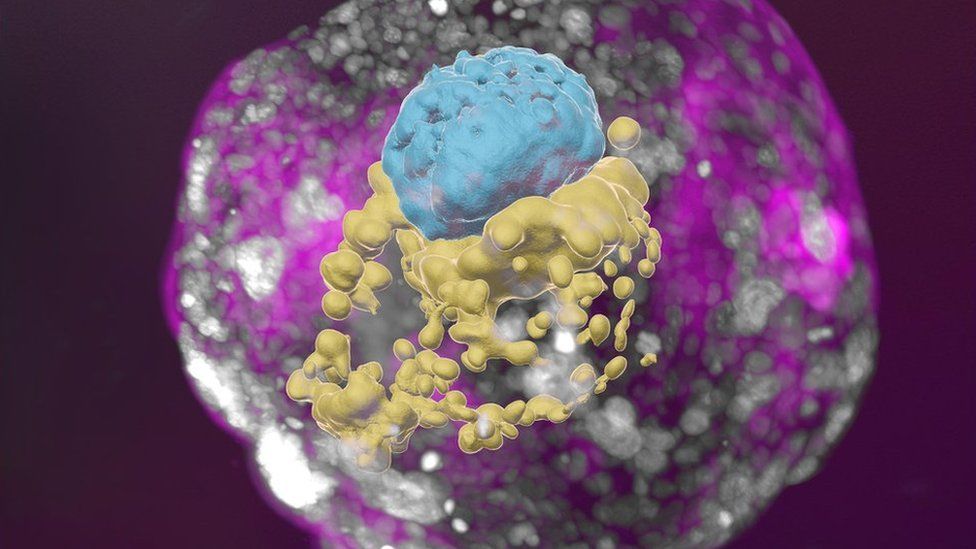The human-like embryo made without eggs or sperm||不含卵子或精子的類人胚胎
Scientists grow whole model of human embryo, without sperm or egg

By James Gallagher Health and science correspondent
Scientists have grown an entity that closely resembles an early human embryo, without using sperm, eggs or a womb.
The Weizmann Institute team say their "embryo model", made using stem cells, looks like a textbook example of a real 14-day-old embryo.
It even released hormones that turned a pregnancy test positive in the lab.
The ambition for embryo models is to provide an ethical way of understanding the earliest moments of our lives.
The first weeks after a sperm fertilises an egg is a period of dramatic change - from a collection of indistinct cells to something that eventually becomes recognisable on a baby scan.
This crucial time is a major source of miscarriage and birth defects but poorly understood.
"It's a black box and that's not a cliche - our knowledge is very limited," Prof Jacob Hanna, from the Weizmann Institute of Science, tells me.
Starting material
Embryo research is legally, ethically and technically fraught. But there is now a rapidly developing field mimicking natural embryo development.
This research, published in the journal Nature, is described by the Israeli team as the first "complete" embryo model for mimicking all the key structures that emerge in the early embryo.
"This is really a textbook image of a human day-14 embryo," Prof Hanna says, which "hasn't been done before".
Instead of a sperm and egg, the starting material was naive stem cells which were reprogrammed to gain the potential to become any type of tissue in the body.
Chemicals were then used to coax these stem cells into becoming four types of cell found in the earliest stages of the human embryo:
epiblast cells, which become the embryo proper (or foetus)
trophoblast cells, which become the placenta
hypoblast cells, which become the supportive yolk sac
extraembryonic mesoderm cells
A total of 120 of these cells were mixed in a precise ratio - and then, the scientists step back and watch.
科學家們在不使用精子、卵子或子宮的情況下培育出了一種與早期人類胚胎非常相似的實體。
魏茨曼研究所團隊表示,他們使用乾細胞製作的“胚胎模型”看起來就像教科書上真實的 14 天胚胎的例子。
它甚至釋放出使實驗室妊娠試驗呈陽性的激素。
胚胎模型的目標是提供一種理解我們生命最早時刻的道德方式。
精子與卵子受精後的最初幾周是一個發生巨大變化的時期——從一組模糊的細胞到最終在嬰兒掃描中可識別的細胞。
這個關鍵時期是流產和出生缺陷的主要根源,但人們對此知之甚少。
“這是一個黑匣子,這並不是陳詞濫調——我們的知識非常有限,”魏茨曼科學研究所的雅各布·漢納教授告訴我。
起始材料
胚胎研究在法律、倫理和技術上都存在爭議。 但現在有一個快速發展的模仿自然胚胎髮育的領域。
這項發表在《自然》雜誌上的研究被以色列團隊描述為第一個“完整”的胚胎模型,用於模仿早期胚胎中出現的所有關鍵結構。
漢納教授說:“這確實是人類第 14 天胚胎的教科書圖像,”這“以前從未有人做過”。
起始材料不是精子和卵子,而是幼稚幹細胞,它們被重新編程以獲得成為體內任何類型組織的潛力。
然後使用化學物質誘導這些幹細胞變成人類胚胎最早階段發現的四種類型的細胞:
外胚層細胞,成為胚胎本身(或胎兒)
滋養層細胞,成為胎盤 下胚層細胞,成為支持性卵黃囊胚外中胚層細胞總共 120 個這樣的細胞以精確的比例混合——然後,科學家們退後一步觀察。